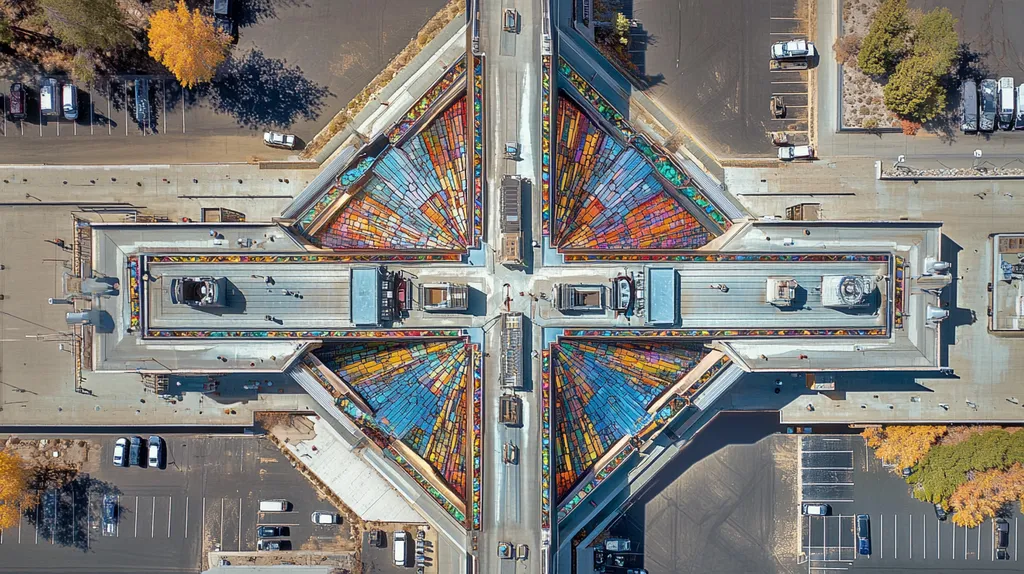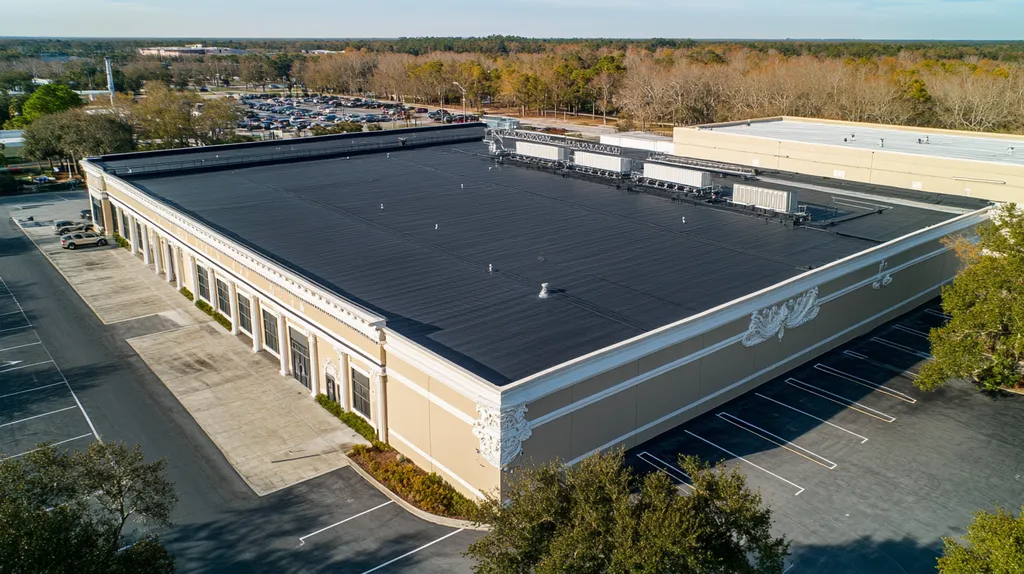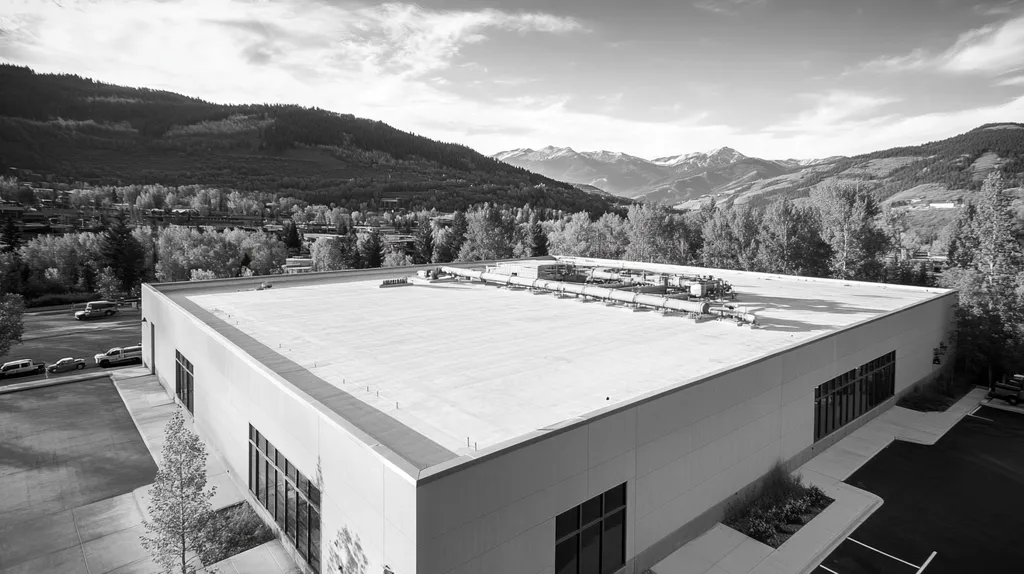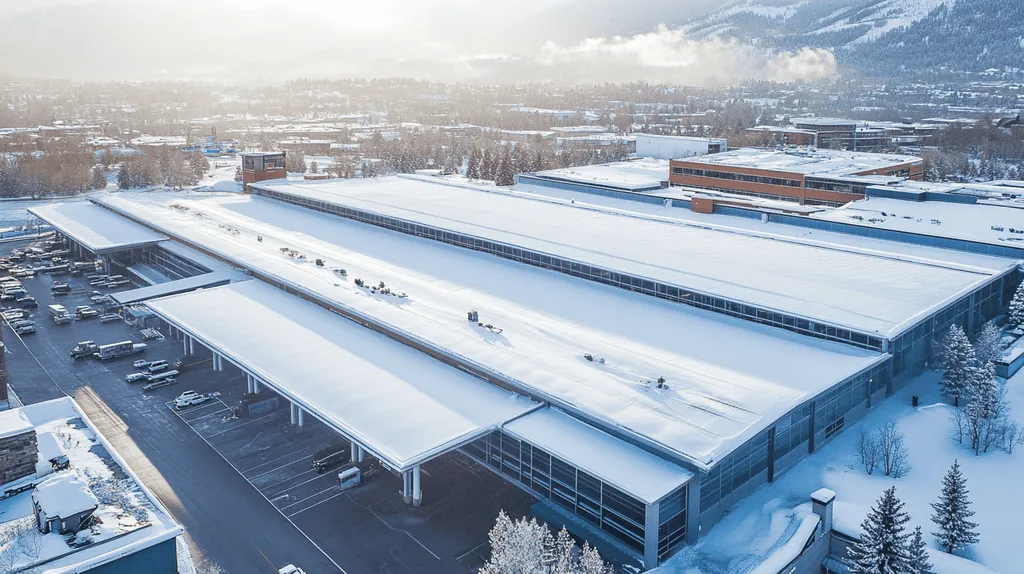In the commercial roofing industry, a startling 73% of safety incidents occur due to inadequate lighting during nighttime maintenance operations. Despite this alarming statistic, myths about roof lighting requirements continue to circulate among facility managers.
The consequences of non-compliance with commercial roof lighting codes extend far beyond simple fines, potentially leading to worker injuries, equipment damage, and costly legal battles.
This comprehensive guide tackles persistent misconceptions about rooftop lighting requirements while providing practical, code-compliant solutions that protect both personnel and property investments.
SECTION 1: COMMON MISCONCEPTIONS
Understanding the rules surrounding rooftop lighting compliance is crucial for any facility manager. Ignorance can lead to severe safety issues, hefty fines, and even legal trouble. Many property owners mistakenly think that lighting regulations don’t apply to rooftop equipment, leaving them at risk for accidents. Furthermore, inconsistently interpreted codes can cause costly renovations and operational headaches. This section aims to shine a light on these myths and stress the need for compliance.
No Lighting Requirements for Rooftop Equipment
A widespread belief is that rooftop equipment doesn’t need any lighting. This assumption poses a serious safety risk, as many facility managers wrongly think maintenance occurs solely during daylight. The reality is that equipment can require attention at any hour, especially in emergencies.
Local and federal regulations often require that rooftops be well-lit to ensure visibility during maintenance tasks. Neglecting these standards can lead to accidents or injuries, resulting in costly legal issues. For example, if a worker sustains an injury due to lack of visibility while servicing equipment, the facility owner could be held liable.
Moreover, proper lighting isn’t just a safety consideration; it’s often necessary to meet insurance and regulatory standards. Failure to provide adequate lighting can void insurance claims for rooftop incidents, adding another layer of urgency to compliance.
In short, facility managers must recognize that lighting is not optional; it’s vital for safe rooftop operation. By ensuring compliance with lighting codes, they mitigate risks and prioritize the well-being of their crew.
Misinterpretation of Local and National Codes
Misreading local and national lighting codes can lead to surprising expenses and headaches for property managers. These codes can be intricate and specific about the types and placements of required lighting on rooftops. A lack of clarity can cause unintentional violations, creating issues that could have been easily avoided.
Some standards might suggest minimal lighting requirements, while others may demand much more robust systems that are necessary for safe rooftop work. This variation can confuse managers, resulting in insufficient safety measures being implemented.
Furthermore, codes are not set in stone; they are updated regularly. Ignoring these changes can lead to noncompliance and associated fines that can burden any facility’s budget. Staying updated on local building codes and national standards is vital.
Ultimately, a solid understanding of applicable codes is essential for compliance and safety. Facility managers should seek expert advice to navigate these regulations correctly and avoid costly mistakes.
Overreliance on GFCI Outlets
Another common misconception among facility managers is the overdependence on Ground Fault Circuit Interrupter (GFCI) outlets as the panacea for electrical safety on rooftops. While GFCI outlets are a great tool for preventing electrocution, they do not eliminate the necessity for proper lighting or code adherence. Many believe that if they install GFCI outlets, their electrical safety concerns are solved, but this overlooks other critical factors.
Relying solely on GFCI outlets can create a dangerous illusion of safety. If the lighting is inadequate, workers are still vulnerable to slips, trips, and falls, regardless of GFCI protection. Rooftops lacking sufficient illumination pose higher accident risks, which can lead to liability concerns.
Moreover, while GFCI outlets are beneficial, they cannot replace the comprehensive wiring and lighting specifications mandated by code. Facility managers should take a holistic approach, ensuring both proper lighting and electrical systems are in place to safeguard workers on rooftops.
Thus, while GFCI outlets play a valuable role, they aren’t a substitute for a complete safety strategy. A thorough, integrated approach is essential to maximize safety and comply with commercial rooftop regulations.
SECTION 2: PRACTICAL IMPLICATIONS
Compliance with commercial roof lighting codes is far more than just ticking boxes—it’s a fundamental aspect of safety and effective operations. Imagine a dimly lit rooftop where maintenance workers navigate like pirates in the dark, vulnerable to accidents and injuries. Furthermore, inadequate lighting can cause equipment to run less efficiently and wear out quicker, costing businesses both time and money. Not to mention, failing inspections due to poor lighting can unleash a wave of penalties that may disrupt operations. This section dives into these pressing issues, emphasizing the urgency of prioritizing compliance for facility managers.
Safety Risks for Maintenance Personnel
Insufficient lighting on commercial roofs significantly heightens the risk for maintenance personnel. Picture workers trying to fix equipment in poorly lit conditions—they’re at greater risk of slips, trips, and falls, a leading cause of workplace injuries acknowledged by OSHA.
Moreover, inadequate lighting can hide dangerous obstacles like loose debris or impending structural issues, which amplifies the chance of serious incidents. This doesn’t just endanger employees—it could also land property owners in hot water due to liability claims.
Understanding that compliance with lighting codes is a proactive measure to enhance safety is key for facility managers. Investing in proper roof lighting protects employees and cultivates a safer work environment.
Plus, well-lit roofs allow for faster, more efficient maintenance, ensuring that small issues are caught before they balloon into costly repairs. In the world of roof management, safety and efficiency are not just linked; they are inseparable.
Impact on Equipment Efficiency and Lifespan
The connection between roof lighting and equipment performance can often be underestimated. Poor lighting may hinder necessary maintenance on critical rooftop equipment, like HVAC systems and chillers. When visibility is diminished, maintaining these systems becomes a real challenge, impacting their overall efficiency.
Consider that dust and debris accumulation on machinery can lead to overheating or worse—mechanical failure. When equipment fails to perform at its best, energy costs surge, directly affecting the bottom line.
Furthermore, if machines are damaged due to delayed maintenance prompted by inadequate lighting, their lifespan dramatically decreases. This not only leads to increased replacement costs but also creates significant operational headaches.
By prioritizing compliance with roof lighting codes, facility managers not only elevate safety but also protect valuable investments in equipment. Efficiently operating systems contribute positively to the overall energy performance of the building.
Compliance Issues with Inspections
Facility managers face serious repercussions if their rooftop lighting falls short of compliance standards. Regular inspections by local authorities can uncover lighting deficiencies, resulting in fines and mandates to correct the issues. Non-compliance can also lead to heightened scrutiny during future inspections.
Take the case of a facility unable to prove adequate roof lighting during an inspection—immediate penalties and a tarnished reputation could be on the line. Additionally, insurance premiums may spike, as insurers may view non-compliance as a heightened risk.
Maintaining compliance isn’t a one-and-done task; it requires ongoing assessments of lighting conditions. Facility managers must remain proactive, ensuring that rooftops are well-lit even as regulations and technology evolve.
Investing in compliance minimizes disruptions and showcases a commitment to safety and regulatory adherence. In today’s competitive landscape, a compliant and well-lit roof can be a distinct advantage that sets a facility apart.
SECTION 3: COST OF MISINFORMATION
The price of misinformation regarding compliance with commercial roof lighting can be staggering. Failing to adhere to regulations not only results in hefty fines but can also inflate operational costs and ultimately expose businesses to litigation. Research indicates that penalties can exceed $100,000 for non-compliance with local and federal rules. In the fierce landscape of today’s market, the stakes are simply too high for facility managers to dismiss these essential factors.
Financial Consequences of Non-Compliance
One of the most immediate repercussions of non-compliance is the financial penalties that can swiftly pile up. Local governments and regulatory bodies routinely impose fines for violations, leaving property owners grappling with unexpected expenses.
Moreover, correcting compliance failures can be a costly affair. Facility managers might be forced to make sudden enhancements to their lighting systems, leading to unplanned expenditures that disrupt financial planning. These unexpected shifts can also necessitate budget cuts in other operational areas.
Beyond fines, non-compliance can affect a business’s attractiveness to potential tenants or clients, leading to lost revenue. Investing in compliance upfront is a wise strategy that can save significant funds in the long run, ensuring financial health and stability.
Ultimately, the ramifications of misinformation extend beyond immediate costs. They can compound over time, affecting profitability and the ability to grow as a business.
Increased Maintenance and Repair Costs
The fallout from misinformation often results in overestimating the reliability of lighting systems. Facility managers sometimes opt for cheaper, non-compliant lighting solutions, believing they will suffice. Yet, these shortcuts typically lead to more frequent breakdowns and repairs, driving up maintenance costs.
Poor compliance also negatively impacts the overall lifespan of roofing systems. Non-compliant installations are more prone to fail, leading to expensive repairs or replacements. Imagine a poorly lit roof contributing to leaks or structural issues—these problems can become very costly to resolve.
Furthermore, the urgency to address compliance problems may lead to hurried work, which often results in errors. These rushed repairs can create a costly cycle of ongoing maintenance woes.
Investing now in compliant, high-quality systems is a strategy that minimizes long-term maintenance needs, ultimately saving both time and money for facility managers.
Potential Legal Liabilities
Non-compliance can expose facility managers to serious legal liabilities. By overlooking regulatory obligations, they risk lawsuits from impacted parties, including contractors or tenants. The financial toll from legal actions can be substantial, leading to costly settlements.
Legal fees can pile up quickly, and even if a facility manager prevails in court, the financial strain from legal disputes can take a hefty toll on business health.
In addition, non-compliance can severely damage a company’s reputation. Organizations facing lawsuits due to compliance issues often suffer from negative public perceptions, discouraging new clients or partners from engaging.
Ultimately, taking a proactive approach to compliance mitigates legal risks and bolsters a company’s reputation as a trustworthy entity. Facility managers must understand that the stakes related to misinformation can extend far beyond immediate concerns, impacting their long-term viability in the market.
SECTION 4: REALITY CHECK
Facility managers need to recognize that compliance with building codes for roof lighting impacts more than just convenience; it’s a critical element of operational safety and legal responsibility. Inadequate rooftop lighting can result in dangerous accidents, putting worker safety at risk and incurring heavy financial costs. As of 2022, OSHA recorded thousands of incidents tied to poor roof access lighting. Familiarity with the National Electrical Code (NEC) and International Mechanical Code (IMC) is vital to ensuring rooftops are both safe and legally compliant.
Understanding NEC and IMC Requirements
The NEC and IMC are essential codes that establish rigorous standards for lighting on commercial roofs, emphasizing both safety and energy efficiency. The NEC specifies electrical standards that must be adhered to when installing roof lighting systems. Non-compliance can lead not only to accidents but also to financial repercussions.
Meanwhile, the IMC augments these regulations by detailing how mechanical systems, including ventilation and lighting, should be implemented. It delineates lighting placements to ensure safe access and effective maintenance of rooftop equipment. Both codes advocate for reliable lighting solutions to facilitate safe navigation on rooftops.
Additionally, compliance with these codes often enhances energy efficiency. Many contemporary lighting solutions are designed to be eco-friendly, assisting in reducing energy expenses while ensuring safety. Facility managers should keep up with these evolving technologies to remain both compliant and economically sound.
Ultimately, understanding NEC and IMC codes is not merely optional; it is a foundational aspect of effective roof management. Ignoring these regulations can compromise staff safety and lead to significant fines.
Local Amendments and Specific Regulations
Local building codes add another level of complexity to compliance, often supplementing NEC and IMC mandates. Each municipality may adopt distinct amendments tailored to their specific safety concerns and environmental challenges. For instance, cities facing severe weather could enforce stricter lighting guidelines to prevent accidents.
This variation can confuse facility managers, particularly those operating across multiple jurisdictions. Failing to comply with local amendments may result in costly delays and legal liabilities, emphasizing the need for ongoing education about local regulations and seeking advice when necessary.
Local codes may also dictate the types of permissible lighting systems, potentially including restrictions on certain technologies or installation protocols. Overlooking these amendments can lead to serious consequences, such as failing inspections or accruing fines.
In summary, facility managers must remain diligent in researching and comprehending both local and national codes. These regulations are vital not only for defining safety standards but also for shaping a comprehensive risk management approach for commercial properties.
Industry Standards for Roof Access Lighting
Compliance with industry standards for roof access lighting is fundamental to ensuring safety on the job. The American National Standards Institute (ANSI) has set specific guidelines that outline minimum lighting levels required for various roof areas. Not meeting these standards can significantly increase the risk of accidents during maintenance activities.
Standards also provide recommendations for the placement and types of lighting fixtures. For example, using directional lighting helps enhance visibility while minimizing glare, which can create hazardous conditions. Durable permanent fixtures are encouraged to ensure reliability against environmental factors.
Moreover, regular audits of the lighting system are essential to maintaining compliance with these standards. Merely installing the correct lights is insufficient; facilities need a comprehensive maintenance plan that ensures all systems operate effectively.
Ultimately, prioritizing industry standards benefits not only property and personnel but also minimizes the potential legal and financial risks associated with non-compliance.
SECTION 5: EVIDENCE-BASED ALTERNATIVES
In today’s commercial landscape, investing in effective roof lighting solutions has never been more crucial. Poorly illuminated roofs can lead to serious compliance issues, skyrocketing fines, and safety risks for employees. Facility managers must get serious about understanding the options out there that can help meet regulatory standards while enhancing functionality. This section will delve into the benefits of permanent lighting solutions, making informed fixture choices, and how to seamlessly integrate lighting into roofing design.
Implementing Permanent Lighting Solutions
Permanent lighting solutions offer lasting advantages for commercial roofs, transforming safety standards and operational efficiency. By ensuring compliance with local codes, these systems help facilities avoid expensive penalties and create a safer work environment. Once installed, permanent lighting often leads to reduced maintenance costs over time.
Additionally, the ability to customize permanent systems to the specific needs of a building allows for targeted illumination in vital areas. For example, LED fixtures can be strategically placed to provide optimal visibility in high-traffic work zones or along emergency exit routes.
Beyond functionality, permanent installations can bolster a property’s aesthetic appeal. A well-lit exterior can enhance the overall professional atmosphere, attracting potential clients and tenants.
Lastly, these modern lighting solutions frequently align with sustainability initiatives. Many energy-efficient options available today support the shift toward greener building practices while still ensuring safety standards are met.
Choosing Appropriate Lighting Fixtures
Selecting the right fixtures is essential for not just compliance, but also for optimal performance. Facility managers should focus on durability, energy efficiency, and maintenance requirements when reviewing lighting options. For instance, fixtures designed to withstand extreme weather conditions can reduce the likelihood of costly replacements.
LED lights have quickly become the preferred choice due to their long lifespan and low energy consumption. Unlike traditional bulbs, which often need replacing and incur higher energy costs, LED options help keep ongoing operational expenses down.
Furthermore, picking fixtures with adjustable brightness can elevate flexibility. This feature allows facility managers to tailor lighting levels according to specific tasks or environmental conditions, enhancing both safety and functionality.
Investing in high-quality lighting not only meets compliance requirements but also helps prevent potential failures. Regular assessments and upgrades to these fixtures will bolster ongoing compliance and operational efficiency.
Integrating Lighting into Roof Design
Successful integration of lighting into roof design is vital for ensuring compliance and maximizing functionality. Inadequate planning can create unnecessary hazards, such as poor visibility in key areas. Therefore, thorough design reviews during the early planning stages are essential.
This integration process encompasses mounting locations, fixture types, and wiring pathways, resulting in a more efficient lighting system overall. For example, lighting that aligns with maintenance routes enhances safety and accessibility during inspections.
Moreover, incorporating lighting into the architectural design promotes visual cohesion while meeting safety standards. Thoughtful placement improves visibility without compromising the integrity of the building’s design.
Lastly, collaborating with roofing and lighting professionals during the design phase is crucial. This partnership will help identify specific regulatory requirements that could influence installation, ensuring compliance while creating a safe working environment.
SECTION 6: TEST AND VERIFY
Compliance with lighting codes is more than just a routine task; it’s a crucial component that underpins safety and operational efficiency. Improper lighting can result in accidents, endangering employee safety and exposing properties to heightened liability risks. The National Fire Protection Association warns that regular testing and verification of lighting installations are key to ensuring facilities meet local codes and steer clear of nasty fines. This section will explore essential practices for maintaining compliance through rigorous inspections, collaborative audits, and meticulous documentation.
Conducting Regular Lighting Inspections
Regular inspections of roof lighting systems are non-negotiable for maintaining compliance and safety. These audits are your safety net, spotting potential problems before they snowball into significant issues, ensuring lights work as intended. Facility managers are encouraged to schedule these critical inspections at least biannually and right after major weather events.
During inspections, teams should evaluate both the functionality and condition of every fixture. Check that all lights are operational while keeping an eye out for signs of wear, such as corrosion, which can jeopardize both integrity and illumination.
Employing thorough documentation for each inspection builds a solid compliance trail, essential during audits or unexpected incidents. Keeping detailed records allows for a quick reference to past issues and repairs, assisting teams in grasping the complete operational history of the lighting systems.
Lastly, the incorporation of technology, like smart sensors, can automate parts of the inspection process. Such systems can alert managers to outages or malfunctions, enhancing efficiency and effectiveness.
Verifying Compliance with Code Officials
Engaging with code officials is a proactive method to solidify compliance. Building relationships with local inspectors offers clarity on specific lighting requirements, providing a roadmap to adhere to codes and avoid missteps that could delay projects.
Before any lighting installation, facility managers should consult with officials to grasp the latest regulations and potential updates. For example, recent code changes may introduce new energy efficiency standards that could greatly influence lighting decisions.
Routine check-ins with officials after installations can further ensure that the actual implementation aligns with the approved plans, fostering collaboration. Inviting inspectors for walkthroughs showcases proactive management and commitment to safety.
In instances where discrepancies arise, swift communication with code officials is essential. Quickly addressing issues minimizes penalties and keeps projects on track, reflecting a culture of compliance rather than an afterthought.
Documenting Lighting Installations and Maintenance
Meticulous documentation of lighting installations and ongoing maintenance is a cornerstone of compliance and operational efficiency. Every detail, from initial design plans to final installations, must be documented thoroughly.
Facility managers should keep comprehensive records that encompass fixture types, installation dates, and maintenance activities. This documentation not only aids during inspections but also underscores a commitment to compliance and safety.
Regular updates to maintenance logs provide valuable insights for decision-making. By analyzing trends in lighting performance, facility managers can make informed choices regarding future upgrades and investments, steering clear of potential issues.
Moreover, leveraging digital documentation tools can streamline these processes, enhancing accessibility. Cloud-based systems enable real-time updates and provide easy sharing capabilities with key stakeholders, ensuring everyone is aligned on compliance matters.
Moving Forward
With 73% of rooftop accidents linked to inadequate lighting, the stakes for proper compliance couldn’t be higher.
The myths surrounding commercial roof lighting requirements continue to put facilities, workers, and bottom lines at risk.
From understanding NEC and IMC requirements to implementing permanent lighting solutions, facility managers must take decisive action to ensure their properties meet or exceed all applicable codes.
The cost of non-compliance – including fines exceeding $100,000, increased insurance premiums, and potential legal liability – far outweighs the investment in proper lighting systems.
By prioritizing regular inspections, maintaining detailed documentation, and staying current with evolving regulations, facility managers can create safer, more efficient rooftop environments while protecting their organizations from unnecessary risk.
FREQUENTLY ASKED QUESTIONS
Q. Are there no lighting requirements for commercial roofs?
A. Many facility managers mistakenly believe lighting isn’t required for rooftops. However, local and federal regulations often mandate well-lit rooftops for safety during maintenance tasks. Ignoring these codes creates risks of accidents and potential legal liabilities, making proper lighting essential for compliance.
Q. How does inadequate lighting on industrial roofs affect safety?
A. Poorly lit commercial roofs increase the risk of accidents during maintenance work. Workers may struggle to identify hazards like debris, heightening the chances of slips or falls. Ensuring proper roof lighting isn’t just about compliance; it’s a crucial step in safeguarding personnel and enhancing operational efficiency.
Q. What financial penalties arise from non-compliance with roof lighting codes?
A. Non-compliance can lead to significant fines, sometimes exceeding $100,000, making it financially burdensome for facility managers. Beyond immediate penalties, rectifying compliance mistakes may result in costly renovations, affecting budget planning and operational continuity.
Q. How do I ensure my commercial roof complies with NEC and IMC codes?
A. Familiarizing yourself with NEC and IMC regulations is essential. These codes define safe lighting standards, so consult the latest guidelines and consider hiring an expert for installation. Regular audits and maintenance check-ups also help ensure ongoing compliance and safety.
Q. Why should I invest in permanent lighting solutions for my roof?
A. Permanent lighting systems provide long-term benefits such as compliance with safety codes and reduced maintenance costs. They offer tailored illumination for high-traffic areas and can enhance your building’s aesthetic appeal while promoting sustainability through energy-efficient practices.
Q. How often should I conduct inspections of my roof lighting systems?
A. Regular inspections are critical—at least twice a year or after major weather events. These inspections should assess the functionality and condition of the lighting systems, documenting any issues to ensure compliance and maintain safety for maintenance personnel.
Q. What’s the best way to document my lighting installations?
A. Keeping detailed records of every aspect of your lighting installations is crucial. Document fixture types, installation dates, and maintenance activities. Utilize digital tools for easy updates, ensuring you maintain a clear history for compliance reviews and future assessment needs.











